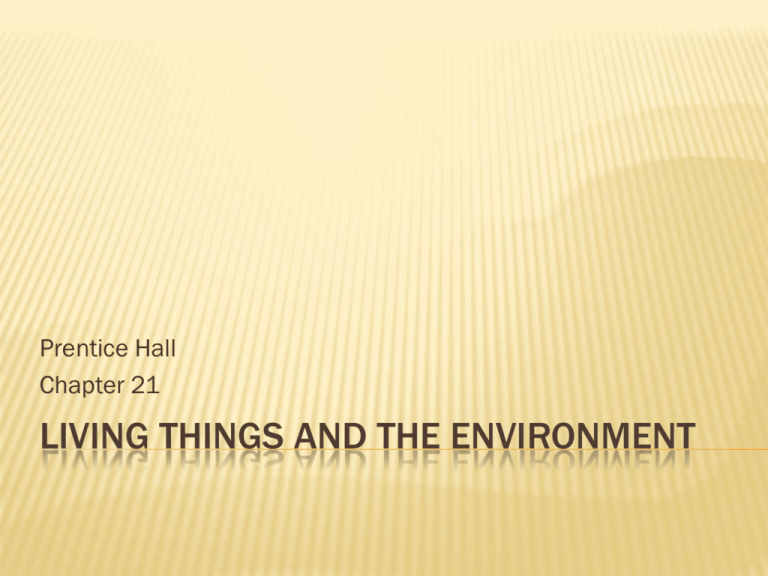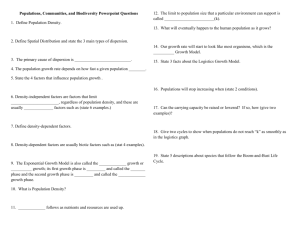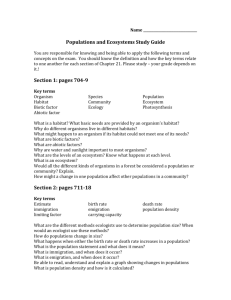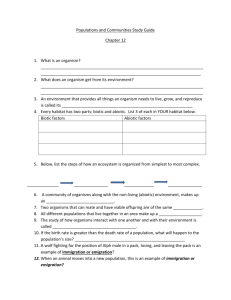Living Things and the Environment
advertisement

Prentice Hall Chapter 21 LIVING THINGS AND THE ENVIRONMENT DEFINE HABITAT. INCLUDE THREE BASIC THINGS ORGANISMS GET FROM THEIR HABITAT AND TELL WHY THEY NEED THOSE THINGS. Habitat: the environment (forest, grassland, desert, tundra, etc.) where living things obtain what they need to live, grow, and reproduce. BASICS: 1. food to live & grow 2. water to live & grow 3. shelter to live and reproduce DEFINE BIOTIC FACTORS AND DESCRIBE THE BIOTIC FACTORS FOUND IN THE HABITAT OF A PRAIRIE DOG. The living parts of a habitat – the organisms, populations, and communities. In a prairie grassland, this includes grass and other plants; seeds and berries; hawks, ferrets, sage grouse, bison, rattlesnakes, badgers, and eagles. Worms, fungi, and bacteria are also biotic factors found in the prairie dog habitat. LIST AND DESCRIBE THE FIVE MAIN ABIOTIC FACTORS OF AN ECOSYSTEM. WATER makes up 65% of the bodies of most organisms and is SUNLIGHT provides the energy for photosynthesis, and therefore OXYGEN is required by most living things to carry out life TEMPERATURE has a major impact on ecosystems. SOIL is a mixture of rock fragments, nutrients, air, water, and the needed to carry out life processes including photosynthesis and cellular respiration. helps begin most food chains processes. For land animals, it is obtained from the air which is about 20% O2. Aquatic organisms require dissolved oxygen. The degree of heat or cold partly determines which plants and animals can survive in an area. decaying remains of living things- along with bacteria and fungi. The type of soil largely determines which plants can grow in an area. SUMMARIZE THE TWO PARTS OF EVERY ENVIRONMENT: 1. BIOTIC: all the LIVING factors in an environment 2. ABIOTIC: all the NON-LIVING factors in an environment (physical factors - such as water, soil, light, and temperature that affect organisms living in a particular area) HOW IS AN ENVIRONMENT ORGANIZED? WHAT ARE THE LEVELS OF ORGANIZATION? ORGANISMS- Individual living things POPULATIONS – same species living together in the same place at the same time COMMUNITY – all the Living populations in a region ECOSYSTEM – living communities along with their non-living (abiotic) surroundings BIOME – group of land ecosystems with similar climate and organisms. Ex.: Rainforest, Desert, Prairie, Deciduous Forest, Tundra. See p. 758. BIOSPHERE - the global sum of all ecosystems. It can also be called the ZONE of LIFE on EARTH * 1-3 are strictly BIOTIC; Interactions between biotic and abiotic components occur at levels 4-6 of an environment HOW ARE THE LEVELS OF THE ENVIRONMENT CONNECTED? As we move to higher levels of organization, the levels include more and more living things, types of habitats, and complexity. DEFINE POPULATION: A population is a group of individuals of the same species that live together in the same area at the same time. Examples: a population of Great Horned Owls, prairie dogs, sage grouse, bison, etc. DEFINE COMMUNITY: Consists of all the populations of different species (plants, animals, protists, bacteria, fungi) that live and interact in an area DEFINE ECOSYSTEM: Is made up of a community of organisms along with abiotic factors DEFINE ECOLOGY: the study of how living things interact with each other and with their environment ECOLOGY LIST AND DESCRIBE FIVE METHODS OF DETERMINING THE SIZE OF A POPULATION. 1. Direct Observation: Locate, count, and tally organisms you 2. Indirect Observation: Calculate numbers by signs of 3. 4. 5. are studying organisms, such as nests, tracks, scat (droppings), or sounds (bird or whale vocalizations) Sampling: Calculate an estimate based on a sample density of organisms in a small area (Ex: 1 m2), and multiply times the number of these units in the study area. Mark-and-Recapture: Mathematical calculation of population size based on capturing, marking, and later recapturing organisms PHOTOGRAPHY: WEB CAMS, MOTION SENSOR REMOTE CAMERAS (trail cameras), STILL PHOTOS CHANGES IN POPULATION SIZE If birth rate › (is greater than) death rate, population size increases. - ---------------------------------- If death rate › (is greater than) birth rate, population size decreases. DEFINE IMMIGRATION: Moving into a population Some Canada geese which used to migrate north for the summer now stay in locations farther south year round, And additional former migrants might immigrate to join these local populations DEFINE EMIGRATION: Leaving a population If food is scarce, members of an antelope herd may wander off in search of better grassland for grazing. If they are permanently separated from the original herd, they will no longer be members of that population. They will have emigrated to a new territory. DEFINE POPULATION DENSITY AND INCLUDE THE EQUATION TO ILLUSTRATE. Number of individuals of a species in a given area: POPULATION DENSITY = NUMBER OF INDIVIDUALS UNIT AREA Example: If you counted 20 monarch butterflies in a garden measuring 10 square meters, the population density would be 20 monarchs per 10 m 2 , or 2 per sq. meter. DEFINE LIMITING FACTORS AND DESCRIBE FIVE EXAMPLES. Definition: environmental factors that cause a population to decrease; any needed resources that can become scarce and result in competition –OR- abiotic conditions that can influence the size of a population ------------------------------------------------------------------ 1. FOOD- Lack of food could mean starvation for some 2. WATER- Dehydration is deadly! 3. LIVING SPACE – Loss or reduction of space or territory makes it less likely that organisms will reproduce 4. WEATHER – Extremes of temperatures can be deadly, and floods can wash away nests and burrows. 5. HUMANS often impact animal and plant populations. When humans develop land for houses and buildings, they cut down trees and change animal and plant habitats. Some animals, like the raccoon and the skunk, can adapt, but other animals can't adapt and their populations are affected. 6. COMPETITION for resources, PREDATION, or DISEASES EXPLAIN CARRYING CAPACITY: the largest population an area can sustain over a long period of time NATURAL SELECTION ANY CHARACTERISTIC THAT MAKES AN INDIVIDUAL BETTER SUITED TO ITS ENVIRONMENT MAY EVENTUALLY BECOME A COMMON TRAIT THROUGH THIS PROCESS. NICHE – is the role of an organism in its habitat, or how it makes its “living,” – this includes the type of food it eats, how it obtains the food, and which other organisms use it as food- is its . . . A niche is the role of a particular species -what it does -- within its habitat. No two species perform precisely the same role in a particular habitat, at least not for long. If they do, competition for food and a place to live results, and one species eventually excludes the other. EXPLAIN HOW THREE DIFFERENT SPECIES OF WARBLERS CAN HAVE 3 DIFFERENT NICHES ALL IN ONE TREE. By feeding in different areas of a spruce tree, the birds avoid competing for food. The Cape May Warbler feeds at the top; the Bay-Breasted Warbler feeds in the middle; the Yellow-Rumped Warbler feeds in the lower part and the bases of the middle branches. DEFINE COMPETITION. INCLUDE EXAMPLES OF COMPETITION FOR FOOD, WATER, SHELTER, SPACE, OR SUNLIGHT. One of the three major types of interactions among living things, competition is the struggle between organisms to survive as they attempt to use the same limited resource. DEFINE PREDATION. INCLUDE “PREY” IN YOUR EXPLANATION. interaction in which one organism (the predator) kills another for food (the prey) HOW DOES PREDATION AFFECT POPULATION SIZES? Populations of predators and prey rise and fall in related cycles. Too many predators = drop in prey populations. Lack of food then causes predators to decline. Too few predators = increase of prey populations. LIST AND ILLUSTRATE EFFECTIVE ADAPTATIONS USED BY PREDATORS AS STRATEGIES TO LOCATE &/OR KILL PREY. Speed – to out-run, out-swim, or out-fly prey (cheetah) Poison – to stun, immobilize, or kill prey Sticky substances to snare insects Light-sensitive eyes that see well in low light (owls) Echolocation: Bats, whales, & dolphins use sound waves to pinpoint location of prey Camouflage to avoid being noticed by prey Group cooperation for hunting LIST AND ILLUSTRATE EFFECTIVE ADAPTATIONS USED BY PREY ANIMALS AS DEFENSE STRATEGIES. Speed Poisons (stinging tentacles of jellyfish) Offensive smells (skunk spray) Mimicry – caterpillar that looks like viper False coloring – False eyespots on wings of moth Protective covering – pangolins, armadillos Camouflage – walking leaf insect Warning coloration – the bright colors of certain insects, reptiles, and amphibians warn that they are poisonous DEFINE SYMBIOSIS: A very close long-term association between two or more species. Thousands of these relationships are found in nature and they are classified according to the impact the association has on the species involved. DEFINE MUTUALISM, COMMENSALISM & PARASITISM IN THE SPACE PROVIDED ON THE CHART. MARK A “+” “-“ OR “0” IN EACH SPACE UNDER THE HEADINGS FOR SPECIES A AND SPECIES B TO INDICATE HOW EACH IS AFFECTED. NEXT, PROVIDE CLEAR EXAMPLES FOR EACH OF THE THREE TYPES OF SYMBIOSIS. THREE TYPES OF SYMBIOSIS RELATIONSHIP DEFINITION - TYPE OF SYMBIOSIS Mutualism : both species benefit Commensalism: SPECIES A “ ” SPECIES “ B” & EXAMPLES & EXAMPLES + Saguaro Cactus gets pollinated + Long-eared bat Gets food + 0 one species benefits; the 2nd Red-tailed hawk species is neither helped nor Gets good nest site harmed in region without trees Saguaro Cactus Not affected Parasitism: + - the parasite benefits and the host is harmed (parasite) (host) Tapeworm or tick Gets food Dog or human Is weakened or made sick DEFINE SUCCESSION: (NATURAL SUCCESSION) the series of predictable changes in vegetation that occur in a natural community over time DEFINE PRIMARY SUCCESSION Primary succession is the slow series of changes in plant life that occurs in areas where . . . no soil or organisms are present, such as a new island formed by the eruption of an undersea volcano or an area of rock uncovered by a melting sheet of ice (retreating glacier). DESCRIBE AND ILLUSTRATE THE STAGES OF PRIMARY SUCCESSION. WHAT ARE PIONEER SPECIES AND HOW DO THEY ARRIVE AT THE LOCATIONS THEY COLONIZE? Pioneer species are the first organisms to populate a bare area. They are often carried by wind or water. Lichens and mosses are often among the first to colonize WHAT ARE LICHENS ? AND HOW DO THEY MANAGE TO LIVE ON THE SURFACE OF ROCKS? Lichens are a combination of fungi and algae growing in a symbiotic partnership. The fungal part dissolves the minerals on rocks to extract nutrients. The algal part photosynthesizes to make food for the lichen. Observe LICHENS at stereoscope and make a detailed, colored drawing ABOVE at 10x or 20x magnification. EVENTUALLY, SUCCESSION MAY LEAD TO A STABLE COMMUNITY THAT DOES NOT CHANGE SIGNIFICANTLY UNLESS . . . the ecosystem is disturbed (by nature or by human actions) WITH PRIMARY SUCCESSION, HOW LONG MIGHT IT TAKE TO REACH A CLIMAX COMMUNITY OF ORGANISMS GROWING IN FERTILE SOIL WITH MATURE PLANTS? It can take centuries to mature to this state— often called a climax community! DEFINE SECONDARY SUCCESSION: The series of changes that occur in an area after the ecosystem has been disturbed. Unlike primary succession, secondary succession occurs in a place where an ecosystem currently exists. DESCRIBE EXAMPLES OF NATURAL EVENTS THAT MAY DISTURB AN ESTABLISHED COMMUNITY AND LEAD TO SECONDARY SUCCESSION. Fires caused by lightning, hurricanes, tornadoes, floods, mudslides, tsunamis, earthquakes WHAT KINDS OF HUMAN ACTIVITIES CAN DISTURB AND ALTER ECOSYSTEMS? Human activities such as farming, housing development, clear-cut logging, strip-mining , mountain top removal mining– or even abandoning fields that were once cultivated – can set the stage for secondary succession. DESCRIBE SECONDARY SUCCESSION. INCLUDE DIAGRAMS, EXPLANATIONS, AND EXAMPLES AT EACH STAGE. WHAT TWO “INGREDIENTS” ARE NECESSARY FOR SECONDARY SUCCESSION TO OCCUR? 1. SoiL 2. Organisms








